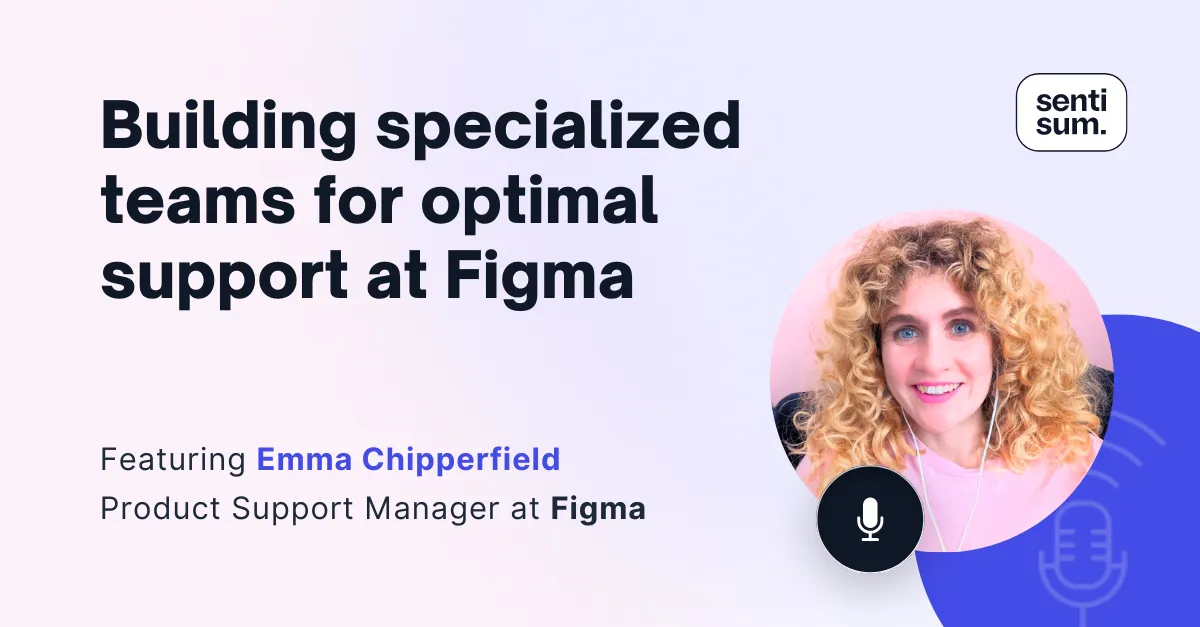In today's episode, we talk to Emma Chipperfield, Product Support Manager at Figma, about how she's been building out specialized teams within the support structure and the benefits of this approach.
We discuss the specialized segments Emma's team is split into, how this helps to improve the support experience, and the impact this approach has had on SLAs and CSAT.
If you're looking to optimize the structure of your support team, Emma also takes us through her advice, including how it's never too early to specialize!
Plus, hear about how Figma encourages all teams to participate in product discovery, and how they keep the unofficial value of "Play" alive throughout the organization.
Watch the full episode, or read the highlights below 👇
How did you identify the need to split your support team into specialized teams?
In startups or smaller companies, you often start out with customer support as a kind of general specialist group of people who have to learn every aspect of support and support every type of customer.
With a company that's hyper growth, you're going to get more types of customers with different, more specialized needs, which requires knowledge from more tenured customer support agents. Oftentimes it's difficult to keep up with that.
As those tenured employees eventually move on, being able to keep that knowledge for every single specialist at the same level just isn't realistic.
Also, as the types of customers we had were evolving and we were having more kind of enterprise companies like Google, BT, Uber other huge companies using Figma day-to-day, we found that we were also having very different types of inquiries coming in that required different skill sets.
What do your specialized segments look like?
There are quite a few specialized teams at Figma, I won't go into all of them now, but one example is a specialized team that looks after our larger organizations.
Enterprise customers may have specific requirements, maybe something like higher security or maybe specific expectations when it comes to first reply time that we need to adhere to.
We also have a growing need for support for engineers as well. A lot of the time our UX designers are putting together a design, sharing it directly with engineers and developers, and they have specific questions about how to implement that or how to replicate that in their app or their website. So with that in mind, we've actually been hiring specialists within customer support with some coding knowledge and background, and that's been really useful because if you think about it, they can then communicate really easily with the engineering customers, but also with our own internal engineers.
It's especially useful if there is a bug or unexpected behavior, as we can replicate that really easily and then escalate the issue quite quickly.
What kind of results have you seen from segmenting your team in this way?
We've seen pretty instant results over the course of implementing specialization. I think going back to where we were in the past, even prior to me joining Figma, there was a larger backlog and there was difficulty in not knowing necessarily exactly where to capacity plan.
When you have those specialized teams, it's easy to look at the volume and say, okay, we need some more people, we need some more resources to dedicate to this area.
Going back to the results though, I'd say definitely our SLA first reply time have been positively impacted.
Also, going back to expectations from enterprise and more mature companies, they have expectations around when we should first get back to them. If we can better matching those expectations, we're naturally going to improve CSAT, so we've seen that in our results.
There's less feedback where people are saying things like "My request is taking too long to get back to", and we have more feedback that's focused on what the agent was like or what their resolution was, which is what you want.
Music: Savour The Moment by Shane Ivers - https://www.silvermansound.com
.svg)




.svg)





